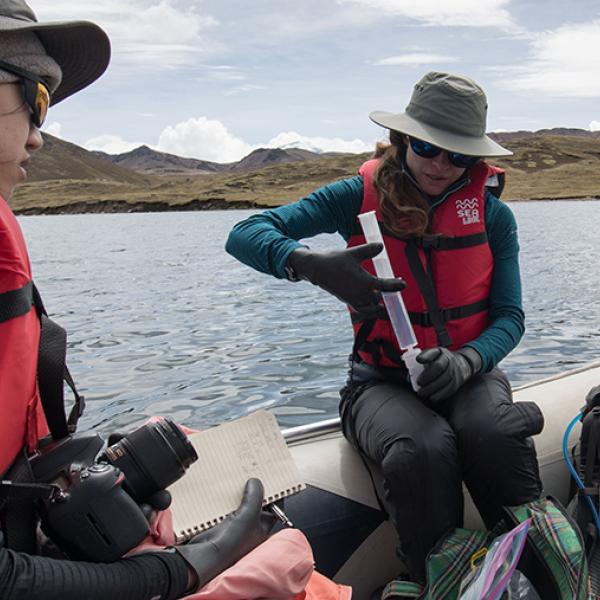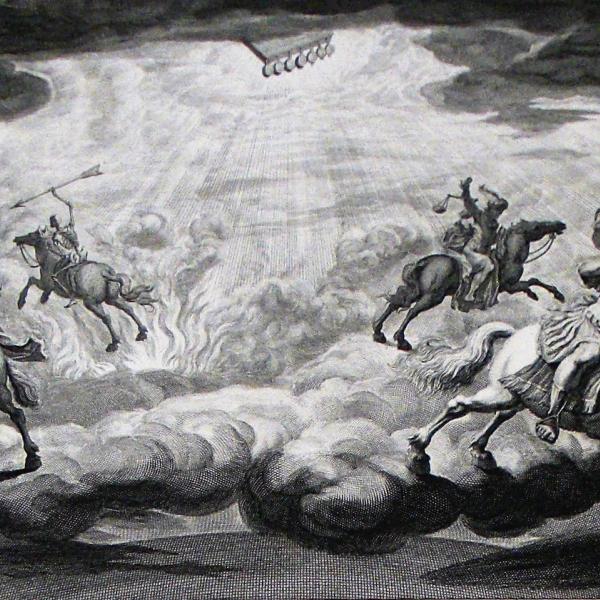In an indigenous Maya community in highland Guatemala, sociocultural anthropologist Kedron Thomas noticed a trend. Despite companies' increased efforts to protect their brands against "piracy," knock-off clothing fashion was everywhere. In her book Regulating Style: Intellectual Property Law and the Business of Fashion in Guatemala, Thomas takes a deep dive into this style scene. What do brands mean for the Maya people of Guatemala? What are the goals and effects of intellectual property laws in this context? Who is a fashion creator, and who is a copycat? And who gets to decide?
Transcript:
Claire Gauen (host): Thanks for listening to hold that thought. I’m Claire Gauen. Today on the show we welcome Kedron Thomas.

Kedron Thomas (guest): My name is Kedron Thomas, and I am an assistant professor of anthropology here at WashU.
CG: Thomas’s latest book begins with a bustling scene in an indigenous Maya community in highland Guatemala. In a central plaza overlooked by a colonial-era Catholic Church, every night after sunset vendors emerge to sell tacos, tamales, and hot drinks. Kids run around playing soccer. Dozens of young men walk around the plaza or hang out by the central fountain – wanting to see and be seen. Like teenagers and young adults everywhere, these men are very particular about their style. The typical uniform is an oversized hoodie with faded blue jeans…
KT:...Usually wide legged, that fall over a pair of very shiny, meticulously kept black leather shoes. This is a really common look. And it's topped off with the gelled hair that you get a glimpse of from underneath this oversized hood that the young men sort of pull up over their heads.
CG: The gelled hair and shiny shoes complete the look, but for the purposes of her book, Thomas was most interested in these young men’s clothing. Specifically, the words scrawled across those jeans and oversized hoodies. Words like “Abercrombie and Fitch” and “Hollister.”
KT: Some of the most popular brand names when I was doing this fieldwork were Abercrombie and Fitch, Ecko, Hollister, Diesel Jeans, Levi's Jeans.
CG: But here’s the thing. None of these outfits were actually purchased from Levis, Abercrombie and Fitch, or Hollister. They’re knock-offs, fakes – and everybody knows it. According to intellectual property law, basically the entire fashion landscape happening in this plaza is illegal. In her work as an anthropologist, Thomas studies things like entrepreneurship, the local effects of global trade policy, and international law. She wanted to know the story behind all this knock-off clothing.
KT: So I wanted to understand - what is the perspective of people in Guatemala about brands, about what they mean, about who owns them, and about the rights that they might feel like they have to be able to use those brands in the ways that they see fit.
CG: Those young men in the square – what did they think about the brand names written on their clothes? What about the people who make the hoodies? Do they understand that they’re breaking the law? Do they care? Who benefits from all these knock-offs, and who, if anyone, is harmed? To really dig into all of these questions, Thomas knew she had to do more than hand out a few surveys. She did the fieldwork for this project between 2006-2012, including a whole year in Guatemala in 2009.
KT: You know, as a cultural anthropologist one of the things that we really try to get at is the feel of everyday life. So not just what do people say about their lives or how do they describe their lives when asked, but what does it really feel like to be there and to be part of what people are experiencing on a daily basis.
As a cultural anthropologist, one of the things that we really try to get at is the feel of everyday life. So not just what do people say about their lives or how do they describe their lives when asked, but what does it really feel like to be there and to be part of what people are experiencing on a daily basis.
CG: So, she started at the beginning – the point of creation. She found a local clothing workshop and volunteered to work there. For eight hours a day, Thomas sat at an industrial sewing machine, seeing and feeling what it’s actually like to be a part of this industry. Most of her coworkers were young guys, 16 or 17 years old. The conditions were not exactly like sitting in an office at WashU.
KT: You know, as a cultural anthropologist one of the things that we really try to get at is the feel of everyday life. So not just what do people say about their lives or how do they describe their lives when asked, but what does it really feel like to be there and to be part of what people are experiencing on a daily basis.
CN: The young guys didn’t mind the dust – they wanted to keep the windows open so they could sometimes lean out and look at pretty girls walking by. The whole scene seems pretty harmless, but remember, to multinational corporations, these men were pirates engaged in criminal activity – stealing brand names and logos. As Thomas found, these men saw themselves and their work quite differently.
KT: They see themselves as producing a product that's important for a local market, and they see themselves as creative. They see themselves as participating in the production of fashion, of style, of taking these symbols that they see on television and that they see in malls, and that they see in catalogs, that they see online, and putting them to use in a way that makes sense for a local population of fashion consumers and at prices that people can afford.
CG: That last point is important. In the parts of Guatemala where Thomas was doing her fieldwork, nobody was going to buy a shirt from Abercrombie and Fitch for 30, 40, 50 US dollars. A decent wage was 6 or 7 dollars a day. So wearing these fashions was not about displaying some sort of wealth or financial status – remember, everyone knows they’re knock-offs. Instead, Thomas found that in this context, brand names had a different kind of value.
KT: It certainly is about showing that you know about fashion. And that you know about what's popular. And that you know about what is stylish, and what is cosmopolitan. So it's very much about exhibiting taste.
CG: Anywhere you go, whether in Guatemala or on a US college campus like WashU, people show their knowledge of style in a bunch of ways. Things like cut, color, and pattern – not wearing flared jeans when everyone else is wearing skinny jeans, that sort of thing. Thomas found that in Guatemala, visual brand names are seen as an important part a garment’s style.
KT: Brands, clothing brands, fashion brands are not just the mark of a multinational company. They are design elements in the clothing that we wear and the accessories that we wear. So if you think of a Louis Vuitton bag, for instance - a Louis Vuitton bag is a bag that is stamped all over the leather with the Louis Vuitton trademark. And that trademark is not just a sign of corporate ownership. It's also a really important design element. And that's what I understood from the people who were creating fashion, manufacturing clothing for a local market in Guatemala. They saw the brand name as part of the design and as part of what makes clothing fashionable in today's global fashion scene.
That's what I understood from the people who were creating fashion, manufacturing clothing for a local market in Guatemala. They saw the brand name as part of the design and as part of what makes clothing fashionable in today's global fashion scene.
CG: So, where do trademarks and intellectual property rights come in? From what we’ve heard so far, you might be thinking that for these business owners in Guatemala, these kinds of laws just get tossed out the window. Because customers will pay for knock-offs, it just doesn’t pay to play by the rules. But Thomas found that that’s not the whole story.
KT: There is a pretty clear set of rules that people follow about what you can copy and what you can share with other people, but it doesn't match up with intellectual property law the way that it's been implemented by the Guatemalan government or in international organizations like the World Trade Organization. So I mentioned that creativity is important, and people see it as very important that whether you're borrowing a design from a multinational corporation like Abercrombie and Fitch or whether you're borrowing a design from a neighbor down the street, that you change something. It's very important that you make some kind of change and make it your own. If you're borrowing from your neighbor, the other thing that's very important is that you do not undercut them in terms of their pricing. So if you sell the same garment the same design for a lower price than your neighbor is selling it for, that is really looked down upon within this economic and social community. People call each other copycats if they do that.
CG: Copy cats. The word does have meaning here. It just means something different than what you might think, given the fact that we’re talking about the knock-off fashion industry. In this context, being a copy cat means that you’re not being creative, not moving fashion forward. It means that you’re hurting your neighbor. It’s a moral norm that helps business thrive in this particular place. Which, given Guatemala’s history, may make more sense than blindly following national or international laws.
There is a pretty clear set of rules that people follow about what you can copy and what you can share with other people, but it doesn't match up with intellectual property law the way that it's been implemented by the Guatemalan government or in international organizations like the World Trade Organization.
KT: There wasn't a day that went by during my fieldwork that I didn't have a conversation with someone about their experience of the violence at the hands of the state or the guerilla army during the internal armed conflict. This lasted 36 years in Guatemala. The peace accords were signed in 1996. And that legacy of violence, that legacy of fear and suspicion about the state, about the military, about the police force, and therefore about the law and authority of the state - that is present every day in Guatemala.
CG: Sitting in the US, it’s easy to sit back and just say “laws are important! just follow the law!” But Thomas found that for many people in Guatemala, when it comes to the government, the police, and the law – things just aren’t that straightforward.
KT: It's one thing to say you need to follow the laws of your country. But when you feel like your country is fundamentally against you, and when you feel like so much of the history of the nation in which you reside is about seeking your extermination - to put it very bluntly - you're less apt to take seriously those kinds of legal demands that are placed on you.
CG: With this in mind, it’s understandable that people in Guatemala might be skeptical of certain laws. And when it comes to trademark law around the globe, Thomas believes that that skepticism might actually be valid.
KT: So one of the things that I thought about a lot during this project was, why do multinational corporations like Gap or Levi's or Abercrombie and Fitch pursue trademark infringement cases? Why do they continue to encourage stricter and stronger trademark law protections around the world? There's conflicting evidence as to whether this actually impacts a corporation's bottom line - the kind of knockoffs that I'm talking about, where it's not counterfeiting, they're not trying to pass something off as original. It's open and acknowledged that these are low quality, cheap imitations that are really only going to be purchased by people who can't afford originals. So what is the real impact on the company, and on its brand? That impact may not be financial. But I argue in the book that multinational corporations are trying to protect their brand image. In trademark law that's referred to as brand dilution. They don't want brand dilution. They don't want that brand image to be diluted in the marketplace. But from a more critical and anthropological perspective, I argue that they're actually trying to protect their brands from brand pollution - which is that they don't want their brand names associated with lower class and racialized and marginalized people who live in parts of the world often that these companies don't want their brands associated with. And for me as an anthropologist, there's something almost a bit troubling about that - that fashion as an industry really driven by a handful of multinational corporations would pursue that kind of exclusivity along racial and class and geographical lines.
For me as an anthropologist, there's something almost a bit troubling about that - that fashion as an industry really driven by a handful of multinational corporations would pursue that kind of exclusivity along racial and class and geographical lines.
CG: Fashion, like entertainment, is a global industry. People in Guatemala see what’s fashionable in the broader world. They see it on tv, in movies, everywhere. But without knock-offs, huge swaths of the world – places like Guatemala that actually house the factories where the originals are made – are told: you don’t get to have this. You can make our clothes. You just can’t wear them.
KT: So that's the other part of this, right, is that certain groups of people are designated - and almost fully designated, legally - as laboring populations, while other populations are designated as rightful consumers. For me that mirrors a divide as well between creators and copycats. So we have laboring copycats on the one hand, and then we have creatively minded consumers on the other hand.
CG: So who is the creator and who is the copy cat? If you look at the actual labor of creating designs and making clothing, it’s not always an easy question to answer.
KT: World-renowned fashion designers openly admit that if not for the designs of so-and-so and so-and-so, I would not be where I am today, right? Openly acknowledging that fashion as a global industry - the world of haute couture - is premised on borrowing and sharing and taking other people's ideas and running with them. And so to then deny that process to whole swaths of the world population - that doesn't really make sense to me, as a cultural anthropologist trying to understand sort of the fundamentals of of human culture and creativity.
CG: Thomas means that – about studying the fundamentals of human nature. Let’s step back and look at the big picture of what we’re talking about here. What does it mean to create? What does it mean to copy? Is there really that big of a difference?
KT: I think that we see as anthropologists that a primary way that we develop culture is through copying. We don't really have another way of doing things. As humans we're constantly copying from one another. We're copying what we see in the world, but we're also transforming those things. We also are creative in moments of pursuing our identities, pursuing our work, pursuing our ways of interacting with other people. So I like to think that in copying but also being creative as a way of developing knockoff fashions, Maya people in Guatemala are not doing something different than what we do in our everyday lives to develop our way of life, to develop our relationship to goods and materials, and to one another. So I think copying is just as fundamental to being human as creativity is, but it certainly hasn't been celebrated as much as the creative aspects of what we do as people. But we're really doing ourselves a disservice if we don't understand copying, borrowing, imitation, appropriation as very important parts of the ways that we grow and develop as individuals and also as societies. That's just a really fundamental part of how we learn and how we do.
We're really doing ourselves a disservice if we don't understand copying, borrowing, imitation, appropriation as very important parts of the ways that we grow and develop as individuals and also as societies.
CG: Many thanks to Kedron Thomas for joining Hold that Thought. Her book on this topic is Regulating Style: Intellectual Property Law and the Business of Fashion in Guatemala. For many more ideas from Arts & Sciences at Washington University in St. Louis, you can find us at holdthatthought.wustl.edu. Thank you for listening.
Credits:
Tecpán, Guatemala via mapio.net
Free Music Archive: Aaron Ximm, Jared C. Balogh, Lee Rosevere, Frenic & Anitek





